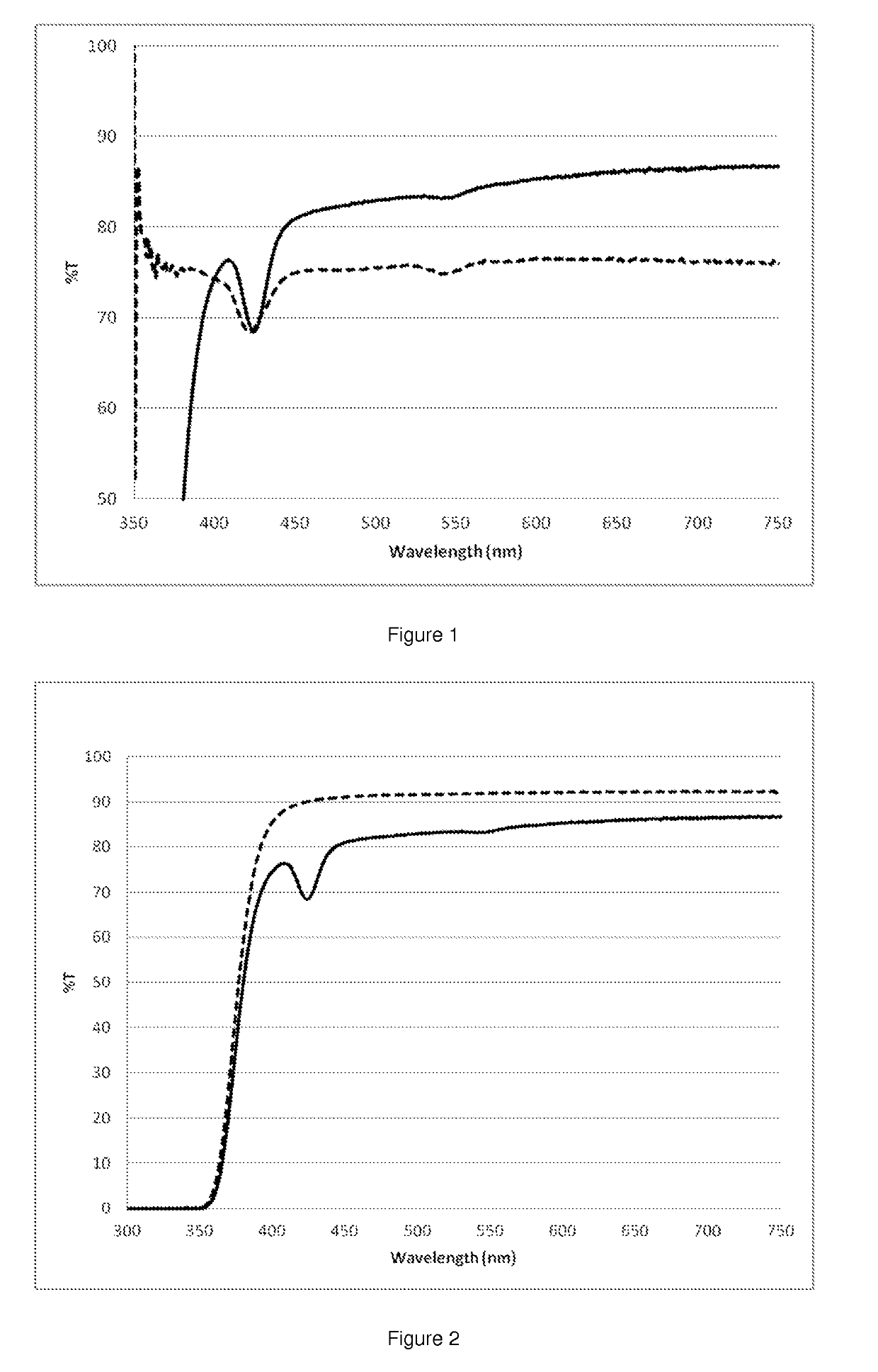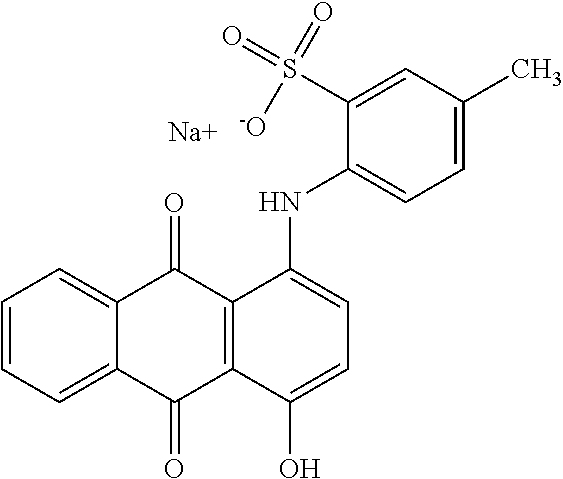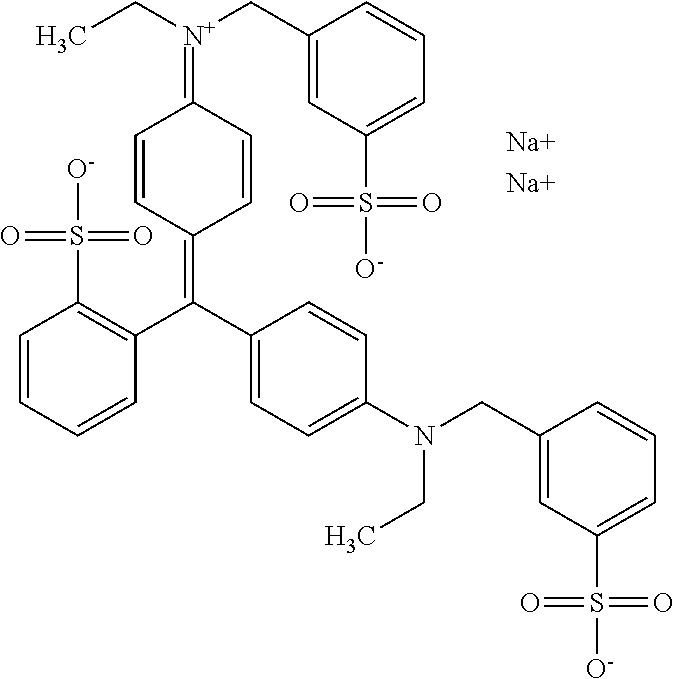Ophthalmic Lens Comprising an Encapsulated Light-Absorbing Additive
a light-absorbing additive and ophthalmic lens technology, applied in the field of ophthalmic lenses, can solve problems such as unsuitable interactions, and achieve the effect of enhancing the phototability of most compounds and increasing the quantum yield of some fluorescent light-absorbing additives
- Summary
- Abstract
- Description
- Claims
- Application Information
AI Technical Summary
Benefits of technology
Problems solved by technology
Method used
Image
Examples
example 1
on of Polymer-Based Nanoparticles Containing a Light-Absorbing Additive by Miniemulsion Polymerization
[0148]A monomer blend (5 g) is prepared from methyl methacrylate and ethylene glycol dimethacrylate in a weight ratio of 50:50, and OMNISTAB™47 (10 mg, available from Deltachem Co. Ltd.) is dissolved in this monomer blend. This blend is added dropwise to 50 ml of an aqueous solution containing SDS (0.5 g) and AIVN (0.05 g) at 80° C. under a nitrogen atmosphere. After completion of the monomer blend addition, the mixture is then further mixed for additional 2 h at 80° C., then centrifuged, washed with ethanol, and dried. The nanoparticles have a size in the range of 200 nm to 1000 nm and a refractive index of 1.5.
[0149]The nanoparticles are dispersed in CR39® (12.5 weight % nanoparticles in monomer) to prepare a masterbatch (Master 1).
example 2
on of Mineral-Based Nanoparticles Containing a Light-Absorbing Additive by Reverse Microemulsion, with Refractive Index Around 1.47
[0150]Ex. 2a: A mixture of cyclohexane (7.5 ml), n-hexanol (1.8 ml), Triton X-100 (1.5 g), OMNISTAB™47 (40 mg, available from Deltachem Co; Ltd), TEOS (0.1 ml) and ammonium hydroxide 30% (0.06 ml) are mixed for 24 h. Then, acetone is added and the particles are collected by centrifugation, washed with ethanol and dried. The nanoparticles have a monodisperse size centered on 100 nm and a refractive index corresponding to precipitated silica, around 1.47.
[0151]The nanoparticles are dispersed in CR-39® (12.5 weight % nanoparticles in monomer) to prepare a masterbatch (Master 2a).
[0152]Ex. 2b: 7.56 g of Triton X-100, 5.86 g hexan-1-ol, 23.46 g cyclohexane, 1.6 ml deionized water, 0.32 ml of methylene blue solution (CAS: 61-73-4, 1% weight solution in water) which is the light-absorbing additive, 0.4 ml of TEOS, and 0.24 ml of 30% ammonium hydroxide solution ...
example 3
on of Mineral-Based Nanoparticles Containing a Light-Absorbing Additive by Reverse Microemulsion, with Refractive Index Higher than 1.5
[0163]Ex. 3a: Nanoparticles obtained in example 2c are introduced in an aqueous solution of 36.5% in weight of tetrabutyl orthotitanate (TBOT).
[0164]1 g of nanoparticle obtained in example 2b is dispersed in 25 ml of 20 vol water: 1 vol ethanol mixture. Then 1.85 ml of HCl (37% weight solution in water) is added in the mixture. The reaction is stirred by magnetic bar for 15 min. After that, 9.1 g of tetrabutyl orthotitanate (TBOT) is added dropwise and mixture is continuously stirred for 3 h at room temperature.
[0165]A thin layer of titania is deposited on the silica based nanoparticles, yielding core shell nanoparticles. These nanoparticles are washed with ethanol, dried at room temperature then annealed at 180° C. for 2 h and have a monodisperse size of 100 nm with a refractive index around 1.54.
A masterbatch is prepared (Master 3a) as for example ...
PUM
| Property | Measurement | Unit |
|---|---|---|
| refractive index | aaaaa | aaaaa |
| size | aaaaa | aaaaa |
| wavelengths | aaaaa | aaaaa |
Abstract
Description
Claims
Application Information
 Login to View More
Login to View More - R&D
- Intellectual Property
- Life Sciences
- Materials
- Tech Scout
- Unparalleled Data Quality
- Higher Quality Content
- 60% Fewer Hallucinations
Browse by: Latest US Patents, China's latest patents, Technical Efficacy Thesaurus, Application Domain, Technology Topic, Popular Technical Reports.
© 2025 PatSnap. All rights reserved.Legal|Privacy policy|Modern Slavery Act Transparency Statement|Sitemap|About US| Contact US: help@patsnap.com



